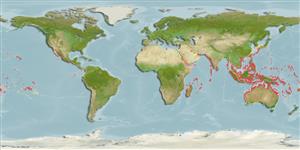Common names from other countries
Environment: milieu / climate zone / depth range / distribution range
Sinh thái học
; Mức độ sâu 0 - 81 m (Ref. 104607), usually 0 - 20 m (Ref. 75831). Tropical
Indo-Pacific: from East Africa, to eastern Polynesia; north to southern Japan and south to Queensland.
Length at first maturity / Bộ gần gũi / Khối lượng (Trọng lượng) / Age
Maturity: Lm ? range ? - ? cm Max length : 4.0 cm SHH con đực/không giới tính; (Ref. 348); common length : 3.0 cm SHH con đực/không giới tính; (Ref. 348)
Commonly collected in many areas, mainly for decorative purposes. Found in intertidal (Ref. 75831), littoral and sublittoral areas with open coral reef and sandy mixed, and seagrass bottoms (Ref. 104607).
Life cycle and mating behavior
Chín muồi sinh dục | Sự tái sinh sản | Đẻ trứng | Các trứng | Sự sinh sản | Ấu trùng
Members of the class Bivalvia are mostly gonochoric, some are protandric hermaphrodites. Life cycle: Embryos develop into free-swimming trocophore larvae, succeeded by the bivalve veliger, resembling a miniature clam.
Poutiers, J.M. 1998. (Ref. 348)
IUCN Red List Status (Ref. 130435)
CITES status (Ref. 108899)
Not Evaluated
Not Evaluated
Threat to humans
Harmless
Human uses
| FishSource |
Các công cụ
Thêm thông tin
Age/Size
Sự sinh trưởng
Length-weight
Length-length
Hình thái học
Ấu trùng
Sự phong phú
Các nguồn internet
Estimates based on models
Preferred temperature
(Ref.
115969): 24.4 - 29, mean 28 (based on 1118 cells).
Vulnerability
Low vulnerability (10 of 100).
